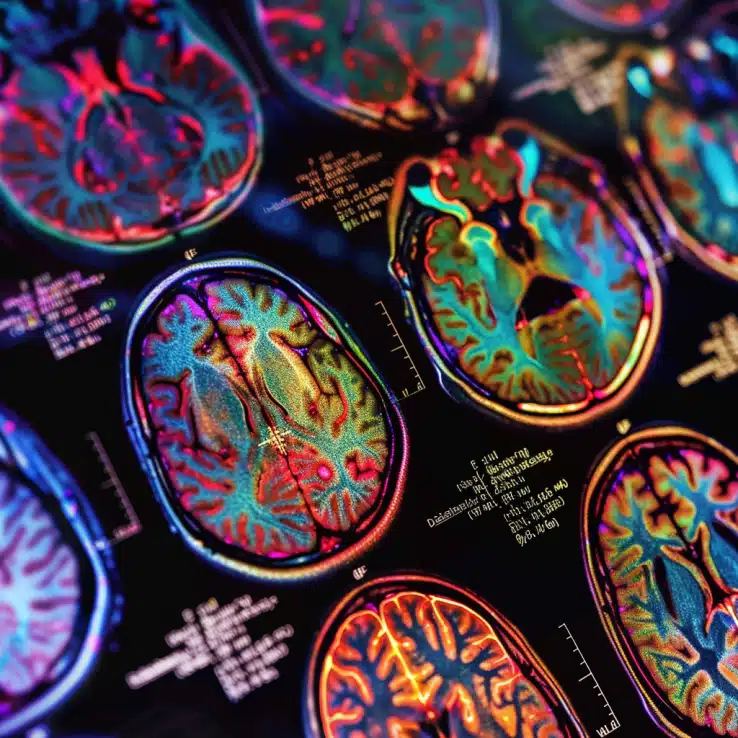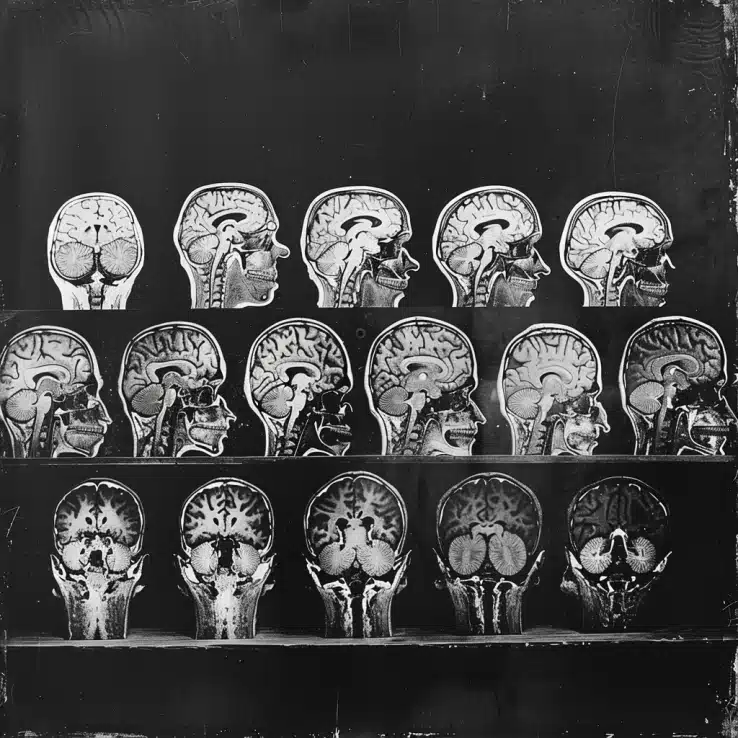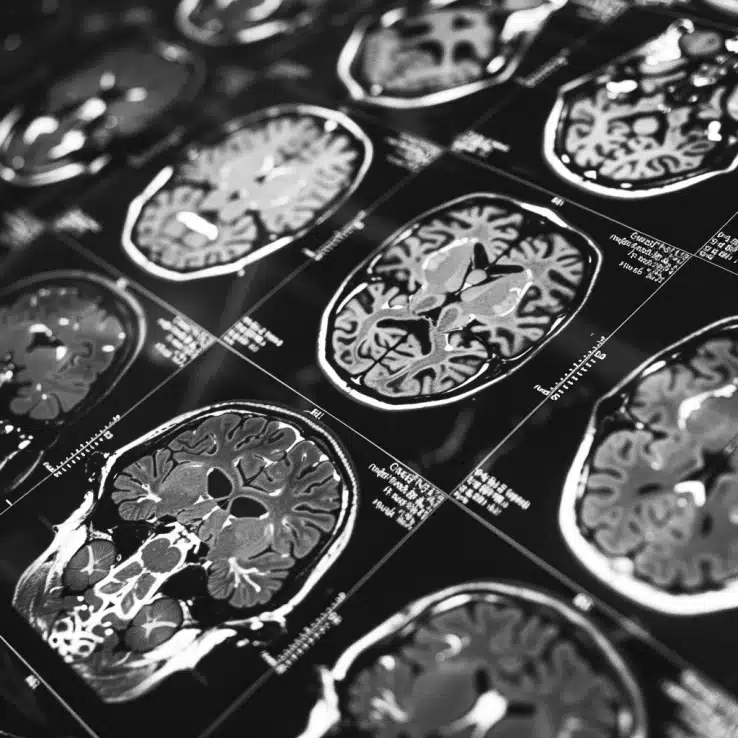Normal aging leads to a decrease in brain volume, with gray and white matter shrinking and cerebrospinal fluid increasing, as measured by synthetic MRI.
Highlights:
- Study Sample: 300 healthy adults (141 males, median age 48; 159 females, median age 50) were analyzed using synthetic MRI.
- Brain Volume Trends: Brain parenchymal volume (nBPV) decreases steadily with age, while cerebrospinal fluid volume (nCSFV) increases.
- Sex Differences: In early adulthood, males had lower normalized white matter volume (nWMV) and myelin volume (nMYV) compared to females, but these peaked later in males.
- Age Patterns: Gray matter volume (nGMV) decreases until the 30s and then stabilizes; significant declines in white matter, total brain volume, and myelin occur in the 60s.
Source: Brain & Behavior (2024)
Major Findings: Age & Sex vs. Brain Volume Changes (2024)
Brain Volumes vs. Age
1. Total Brain Volume (nBPV)
Decrease with Age: Both men and women lose brain volume as they age.
Faster Decline After 60: This loss speeds up significantly after age 60.
2. Fluid in the Brain (nCSFV)
Increase with Age: The amount of cerebrospinal fluid, which cushions the brain, increases as we get older.
Noticeable Changes After 60: This increase becomes more pronounced after age 60.
3. White Matter (nWMV)
Increase and Then Decrease: White matter volume increases in early adulthood and then starts to decrease.
Peaks Differently by Gender: In women, it peaks around their 30s; in men, it peaks around their 40s.
4. Myelin (nMYV)
Similar Pattern to White Matter: Myelin, the protective sheath around nerves, also increases and then decreases.
Peaks Later in Men: The volume of myelin peaks later in men than in women, with significant declines after age 60.
5. Gray Matter (nGMV)
Early Decline and Stabilization: Gray matter decreases until the 30s and then stabilizes in both men and women.
Sex Differences (Men vs. Women)
1. White Matter & Myelin
Early Adulthood Differences: In their 20s, men have lower volumes compared to women.
Different Peak Times: Women’s volumes peak in their 30s, while men’s peak in their 40s.
2. Gray Matter
Decline Until 30s: Both men and women see a decline in gray matter until their 30s, after which it stabilizes.
3. Comparing Age Groups
White Matter & Myelin: There are significant differences between men and women in various age groups, especially in their 20s, 30s, 40s, and 50s.
Gray Matter: Women have more gray matter than men in their 40s and 60s.
Brain Fluid and Overall Volume: Men have more brain fluid and less overall brain volume compared to women in various age groups.
Potential Effects & Implications of Age-Related Brain Changes

Cognitive Decline
Memory & Learning
Decreased Gray Matter (nGMV): The reduction in gray matter, which is crucial for processing information and memories, could explain why older adults often experience memory lapses and slower learning speeds.
Stability Post-30s: While gray matter declines until the 30s and then stabilizes, the early reduction might impact cognitive development and performance during mid-life.
Information Processing
White Matter (nWMV) Decline: White matter facilitates communication between different brain regions. Its decrease after peaking might slow down the brain’s processing speed and the ability to multitask.
Motor Skills & Coordination
Myelin Loss
Decline After 40s: Myelin protects nerve fibers and ensures swift signal transmission. As myelin volume decreases, especially after the 40s, it might lead to slower reflexes, reduced coordination, and increased susceptibility to falls and injuries.
Mental Health
Increased Brain Fluid (nCSFV)
Fluid Buildup: An increase in cerebrospinal fluid might indicate brain atrophy, where brain tissue shrinks and leaves more space for fluid. This condition is often linked with neurodegenerative diseases like Alzheimer’s and could explain the rise in such conditions among older adults.
Structural Changes and Mental Disorders
Volume Reductions: Changes in brain structure, including reduced overall brain volume (nBPV), could contribute to mental health disorders. Depression, anxiety, and other psychiatric conditions might become more prevalent or severe due to these structural changes.
Study Overview: Age & Sex-Related Brain Volume Changes in Adults (2024)

Researchers investigated age- and sex-related brain volume changes in healthy adults using synthetic MRI and to provide specific reference values for these changes.
Sample
Participants: 300 healthy adults
- Males: 141 (Median age 48, age range 22-81)
- Females: 159 (Median age 50, age range 21-85)
Methods
Imaging Technique: Synthetic MRI performed on a 3.0 T MRI scanner.
Volumes Measured:
- Brain parenchymal volume (BPV)
- Gray matter volume (GMV)
- White matter volume (WMV)
- Myelin volume (MYV)
- Cerebrospinal fluid volume (CSFV)
Normalization: Volumes normalized by intracranial volume (ICV) to account for individual head size differences.
Statistical Analysis:
- Brain volumes plotted against age for both sexes.
- Curve fitting models (quadratic curves) used to explain age dependence.
- Comparisons made between different age and gender groups using appropriate statistical tests.
Limitations
- Cross-Sectional Design: The study’s cross-sectional nature may not capture individual longitudinal changes.
- Exclusion Criteria: Excluded participants with major medical conditions, neurological, or psychiatric disorders, which may limit generalizability.
- Life Background Factors: Did not consider factors like hypertension, race, drinking, smoking, and occupation, which might influence brain volume.
- Sample Size Distribution: Unequal distribution of participants across age groups could introduce bias.
Conclusion: Age & Sex-Related Brain Changes in Adulthood
This study effectively establishes age- and sex-specific reference values for brain volumes using synthetic MRI, offering a robust tool for differentiating normal brain aging from pathological conditions.
By providing detailed insights into how brain volumes change across the lifespan, the research underscores significant patterns such as the steady decline in overall brain volume and the increase in cerebrospinal fluid with age.
The findings highlight the importance of considering both age and gender when assessing brain health, as these factors influence the timing and extent of changes in white matter, gray matter, and myelin volumes.
These reference values can enhance early diagnosis and targeted interventions, ultimately improving the management of neurodegenerative diseases and other brain disorders.
References
- Study: Evaluating age‐and gender‐related changes in brain volumes in normal adult using synthetic magnetic resonance imaging (2024)
- Authors: Zuofeng Zheng et al.







